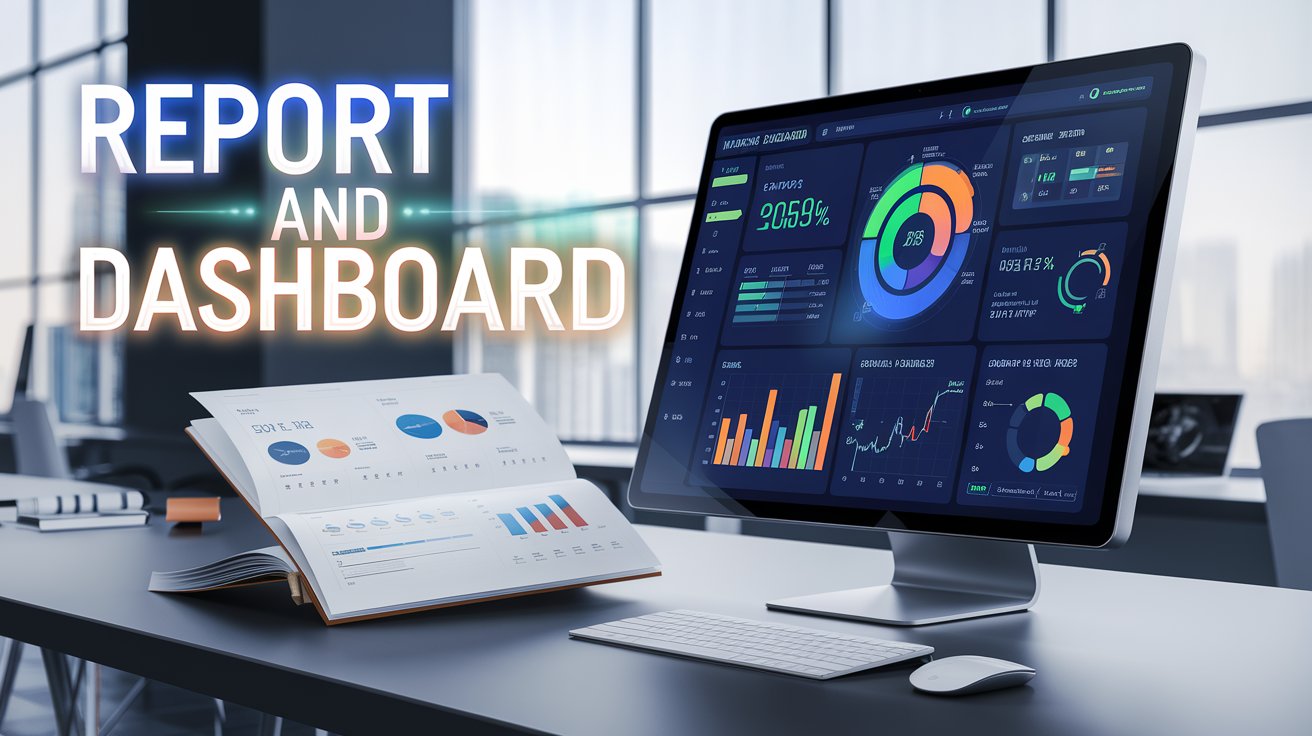In today’s data-driven world, reports and dashboards have become indispensable tools for businesses, organizations, and individuals seeking to make informed decisions. These tools transform raw data into actionable insights, enabling efficient monitoring, analysis, and strategy formulation.
This article explores the concepts, benefits, and best practices of creating and using reports and dashboards effectively.

What Are Reports and Dashboards?
Reports
Reports are extensive, generally static papers that give information and insights based on data. They are commonly used to assess trends, summarize performance, and give detailed analysis. Reports are intended to answer specific issues and are often given on a periodic basis.
Dashboards
Dashboards, on the other hand, are dynamic visual interfaces that provide data insights in real or near-real time. They employ charts, graphs, and metrics to demonstrate key performance indicators (KPIs) and trends, allowing users to track progress and make quick decisions.
Try Free Demo! https://axonator.com/request-for-demo/
Key Differences Between Reports and Dashboards
Reports and dashboards, while both useful tools for data analysis and decision-making, serve different functions and address different demands.
Reports are primarily static documents intended for in-depth study and extensive examination of data over a set time period. They are frequently prepared at regular intervals, such as weekly or monthly, and are used for strategic planning and extensive evaluations.
Dashboards, on the other hand, are dynamic, real-time visual interfaces designed to improve operational efficiency by displaying key performance indicators (KPIs) at a glance. They are dynamic and constantly updated, making them perfect for rapid monitoring and decision-making.
While reports provide a detailed perspective of data, dashboards focus on visual simplicity and real-time insights, allowing users to swiftly analyze and act on essential information.
Benefits of Reports and Dashboards
1. Enhanced Decision-Making
Both tools provide clear insights into data, allowing stakeholders to make well-informed decisions based on facts rather than intuition.
2. Improved Efficiency
Dashboards save time by providing a quick overview of essential metrics, while reports eliminate the need for manual data compilation and analysis.
3. Better Collaboration
Reports can be shared across teams to ensure alignment, and dashboards encourage real-time collaboration by offering shared views of live data.
4. Increased Accountability
By tracking KPIs and goals, these tools hold teams accountable for their performance and progress.
Best Practices for Creating Effective Reports and Dashboards
1. Define Clear Objectives
Determine the purpose of your report or dashboard. Understand the questions you want to answer and the goals you want to achieve.
2. Use Relevant Data
Ensure the data used is accurate, up-to-date, and relevant to the audience. Avoid overwhelming users with excessive or irrelevant details.
3. Focus on Visualization
Use charts, graphs, and other visual aids to make data easier to understand. For example:
- Bar charts for comparisons
- Line graphs for trends over time
- Pie charts for proportions
4. Prioritize User Experience
Design dashboards and reports with the end user in mind. Organize information logically and avoid clutter.
5. Integrate Real-Time Data
For dashboards, connect them to real-time data sources to provide the most current insights.
6. Leverage Automation
Automate the generation and distribution of reports and dashboards to save time and ensure consistency.
Know More! https://axonator.com/report-and-dashboard/
Popular Tools for Reports and Dashboards
1. Microsoft Power BI
A powerful tool for creating interactive dashboards and reports with advanced analytics features.
2. Tableau
Known for its intuitive interface and strong data visualization capabilities.
3. Google Data Studio
A free tool ideal for creating custom dashboards using Google and other data sources.
4. Axonator
An excellent choice for mobile-based reporting and dashboards, designed for field operations and workflows.
Future Trends in Reports and Dashboards
- Artificial Intelligence (AI) Integration: AI-driven dashboards will provide predictive insights and automate analysis.
- Customizable Dashboards: Tailored dashboards catering to individual user needs will become more prevalent.
- Mobile Accessibility: Mobile-friendly reports and dashboards will ensure data is always at your fingertips.
- Enhanced Collaboration: Tools will incorporate real-time commenting and shared workspaces.
Reports and dashboards are vital for translating data into actionable insights. While reports provide a comprehensive view for strategic decision-making, dashboards excel at real-time monitoring and operational efficiency. By leveraging the right tools and following best practices, organizations can harness the full potential of their data to stay competitive and achieve their objectives.
Embrace reports and dashboards today to unlock the power of data-driven decision-making!
About Axonator Inc:
At Axonator, our vision is bold and transformative: to mobilize the world. We see a future where businesses and communities are effortlessly interconnected through the power of mobile technology. Our mission is to equip organizations globally with cutting-edge mobile solutions, unlocking new possibilities for innovation, efficiency, and seamless collaboration in every facet of their operations.
Contact:
Axonator Inc. (The World On Mobile)
Austin, TX, USA
USA: +1-716-274-8885
India: +91-8600-032-635
Email: support@axonator.com
Website: https://axonator.com/
